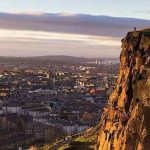There are many reasons why a significant number of Church of Scotland members decided to leave and form their own Free Church. Perhaps the main reason was the total lack of democracy within the ruling body of the Church, coupled with the Patronage Act that had been introduced by Queen Anne around 1712. The appointment of Elders who made up the Kirk Session, were in almost all cases selected from the upper classes, and therefore not a true cross section of the membership. The Patronage Act by which ministers were appointed by the Sovereign or a local landowner acting on their behalf meant that the congregations took no part in the selection. This lead to several court cases where the congregations had blocked the minister from entering, and they were heavily fined. This Act was only erased from the statute book in 1874.
In January 1843, there were two Churches in Liberton Parish, Liberton Kirk that had been under the ministry of Rev. James Begg since 1835, and Gilmerton Church, which was originally an extension of the Kirk, under the ministry of Rev. Walter Fairlie since 1838. Rev. James Begg chaired his last Liberton Kirk Session on 2nd May 1843, and both he and Rev. Fairlie joined the newly formed Free Church on 18th May, and signed the Act of Separation and Deed of Demission, on 23rd May 1843. Rev. Begg became minister of the Newington Free Church, taking about 200 of the Kirk Members with him, and went on to become Moderator of the Free Church in 1865. Rev. Fairlie formed the Free Church of Gilmerton, and chaired his first Session meeting in the “Large Hall” at Gilmerton on 11th September 1843.
There is some evidence to suggest that meetings held before the first Sessions Meeting, were held in Gilmerton Church, until Liberton Kirk Sessions who were responsible for the church at Gilmerton, asked for the return of the Church keys on 14th July. The following meeting on 16th July was held out of doors, before making use of the “Large Hall” for later meetings.
Most of the Gilmerton congregation followed Rev. Fairlie to the Free Church, leaving only a few in the Church of Scotland, as a result, between 1843 and 1860 Gilmerton was served by a succession of licentiate ministers until the appointment of Rev. Thomas Fleming.
The General Assembly of the Free Church was held in Glasgow on 17th October, where a representative from Gilmerton was present.
At a congregational meeting held at Gilmerton on 17th March 1844, six Deacons were appointed, namely, Thomas Craig, Alexander Johnston, John Paterson Taylor, William Jordan, Robert Blair, and Robert McLeod. The post of Deacon in the Free Church was similar to that of Heritors in the Church of Scotland, in that they were responsible for the buildings and fabric of the Church.
Since May 1843, collections had been taking place in order to build a local Church and Sunday school, and building had started at the junction of what we now call Ellen’s Glen Road and Ellen’s Glen Loan, in the village of Stenhouse, shortly after this date. On 2nd June 1844, the Church was officially opened, and the first services were held, Rev. Fairlie preached in the morning, Rev. Robert Ferguson in the afternoon, and Rev. George Davidson in the evening. The first Sessions meeting in the Stenhouse Church, was held three days later, on the 5th June. The Church was secured by a Feu Charter to the Free Church, and the total cost of church and Sunday school was £637 pounds 9 shillings and four pence, and the debt still owing at this time was £342 and 10 shillings. There was no manse, and at that time, no prospect of one in the foreseeable future. The church was now known as the Free Church of Liberton and Gilmerton, but a few months later Gilmerton was dropped from the title. By early 1845 the number attending church including children was over 200, and two Sunday Schools were operating.
By 1868, the congregation had outgrown the Stenhouse Church, and a new church was built in 1869, at the junction of Gilmerton Road and Claverhouse Drive, called the Liberton Free Church.
Rev. Walter Fairlie died in 1856, when Rev. Dr. D.K. Guthrie became minister, followed by Rev. G. Dodds in 1890. In 1900 the Free Church voted by a very large majority, to join their fellow travellers of the United Presbyterian Church to form the United Free Church, and the church at Northfield became a United Free Church. The minority who voted against union, continued as the Free Church of Scotland. A pipe organ was installed in 1903 and electric light installed at the manse built in 1870 (Now Northfield House) in 1925, with electric light into the church in 1926. Following a meeting of the United Free Church in 1929, a large majority voted to join with the Church of Scotland, and the church became Northfield Church of Scotland Church, where Rev. Dodds continued as minister until 1933. The minority who voted against, became The Free Church (Continuing).
In compiling this short history, I am indebted to Mr W.S. Anderson, author and well-known authority on the Free Church, for his advice on this subject. Thanks are also due to Rev. J. McPake of Liberton Northfield, for allowing me access to a large amount of archival material.









jalowkicielne
*Aw, this was a really nice post. In idea I would like to put in writing like this additionally ? taking time and actual effort to make a very good article? but what can I say? I procrastinate alot and by no means seem to get something done.
Hairstyles
Have you ever thought about adding a little bit more than just your articles? I mean, what you say is valuable and all. But imagine if you added some great photos or video clips to give your posts more, “pop”! Your content is excellent but with images and videos, this website could definitely be one of the very best in its field. Superb blog!